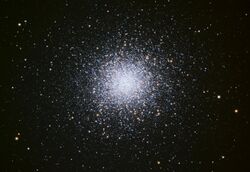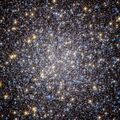Astronomy:Messier 13
| Messier 13 | |
|---|---|
 Globular cluster Messier 13 in Hercules captured with an amateur telescope in 2025. | |
| Observation data (J2000 epoch) | |
| Class | V[1][2] |
| Constellation | Hercules |
| Right ascension | 16h 41m 41.24s[3] |
| Declination | +36° 27′ 35.5″[3] |
| Distance | 24.1 kly (7.4 kpc)[4] |
| Apparent magnitude (V) | 5.8[5] |
| Apparent dimensions (V) | 20 arcminutes |
| Physical characteristics | |
| Absolute magnitude | –8.5 |
| Mass | 6×105[6] M☉ |
| Radius | 84 ly[7] |
| Metallicity | = –1.33[8] dex |
| Estimated age | 11.65 Gyr[8] |
| Notable features | One of the best-known clusters of the Northern Hemisphere |
| Other designations | NGC 6205[5] |
Messier 13, or M13 (also designated NGC 6205 and sometimes called the Great Globular Cluster in Hercules, the Hercules Globular Cluster, or the Great Hercules Cluster), is a globular cluster of several hundred thousand stars in the constellation of Hercules.
Discovery and visibility
Messier 13 was discovered by Edmond Halley in 1714,[2] and cataloged by Charles Messier on June 1, 1764,[9] into his list of objects not to mistake for comets; Messier's list, including Messier 13, eventually became known as the Messier catalog.[10] It is located at right ascension 16h 41.7m, declination +36° 28'. Messier 13 is often described by astronomers as the most magnificent globular cluster visible to northern observers.[2]
About one third of the way from Vega to Arcturus, four bright stars in Hercules form the Keystone asterism, the broad torso of the hero. M13 can be seen in this asterism 2⁄3 of the way north (by west) from Zeta to Eta Herculis. With an apparent magnitude of 5.8,[2] Messier 13 may be visible to the naked eye with averted vision on dark nights.[2] Messier 13 is prominent in traditional binoculars as a bright, round patch of light.[2] Its diameter is about 23 arcminutes and it is readily viewable in small telescopes.[11] At least four inches of telescope aperture resolves stars in Messier 13's outer extent as small pinpoints of light. However, only larger telescopes resolve stars further into the center of the cluster.[12] The cluster is visible throughout the year from latitudes greater than 36 degrees north, with the longest visibility during Northern Hemisphere spring and summer.[13]
Nearby to Messier 13 is NGC 6207, a 12th-magnitude edge-on galaxy that lies 28 arcminutes directly northeast.[14] A small galaxy, IC 4617, lies halfway between NGC 6207 and M13, north-northeast of the large globular cluster's center. At low powers the cluster is bracketed by two seventh-magnitude stars.[15]
Characteristics

About 145 light-years in diameter, M13 is composed of several hundred thousand stars, with estimates varying from around 300,000 to over half a million.[15] The brightest star in the cluster is a red giant, the variable star V11, also known as V1554 Herculis,[16] with an apparent visual magnitude of 11.95. M13 is 22,200 to 25,000 light-years away from Earth,[9] and the globular cluster is one of over one hundred that orbit the center of the Milky Way.[17][18]
The stars in this cluster are firmly in the Population II category, markedly lower in metals than Population I stars like the Sun and most other stars in the Sun's close proximity. M13 as a whole has only about 4.6% as much iron as the Sun does.
Single stars in this globular cluster were first resolved in 1779.[9] Compared to the stars in the neighborhood of the Sun, the stars of the M13 population are more than a hundred times more densely packed.[9] They are so close together that they sometimes collide and produce new stars.[9] The newly formed, young stars, known as "blue stragglers", are particularly interesting to astronomers.[9]
The last three variables (V63, V64 and V65) were discovered from Spain in April 2021, March 2022 and January 2024, respectively.
Arecibo message
The 1974 Arecibo message, which contained encoded information about the human race, DNA, atomic numbers, Earth's position and other information, was beamed from the Arecibo Observatory radio telescope towards Messier 13 as an experiment in contacting potential extraterrestrial civilizations in the cluster. M13 was chosen because it was a large, relatively close star cluster that was available at the time and place of the ceremony.[19] The cluster will move through space during the transit time; opinions differ as to whether or not the cluster will be in a position to receive the message by the time that it arrives.[20][21]
Literary references
- The science fiction novellas "Sucker Bait" by Isaac Asimov and the novel Question and Answer by Poul Anderson take place on Troas, a world within M13.
- In the German science fiction series Perry Rhodan, M13 is the location of Arkon, the homeworld of the race of Arkonides.
- In author James Blish 's Cities In Flight, the alien "Web of Hercules" attacks from this cluster.
- In author Dan Simmons' Hyperion Cantos the Hercules cluster is where a copy of Earth was secretly recreated after the original was destroyed.
- In his novel The Sirens of Titan, Kurt Vonnegut writes "Every passing hour brings the Solar System forty-three thousand miles closer to Globular Cluster M13 in Hercules—and still there are some misfits who insist that there is no such thing as progress."
- Messier 13 is the home of the antagonistic aliens in the 1977 space opera The War in Space, who hail from the third planet of a system orbiting a star called Yomi.
- Deliberately engineering a star in Messier 13 to go nova was part of the Cybermen's complicated plot in the 1968 Doctor Who story The Wheel in Space.
In art
- Messier 13 is featured as part of the interior of the dome of St Anne's Church, Kew in London, based on a photograph by NASA. Halley discovered the galaxy in 1714, the same year that the church was first dedicated.[22]
Gallery
-
M13 is in the "armpit" of the constellation Hercules.
-
Heart of the Hercules Globular Cluster, Hubble image
-
Hubble images comparing M13 and M3
-
M13 in near infrared and visible light
-
M13 painted on the interior of the dome ceiling of St Anne's Church, Kew.
See also
References
- ↑ Shapley, Harlow; Sawyer, Helen B. (August 1927), "A Classification of Globular Clusters", Harvard College Observatory Bulletin 849 (849): 11–14, Bibcode: 1927BHarO.849...11S.
- ↑ 2.0 2.1 2.2 2.3 2.4 2.5 Thompson, Robert Bruce; Thompson, Barbara Fritchman (2007). Illustrated Guide to Astronomical Wonders: From Novice to Master Observer. DIY science. O'Reilly Media, Inc. p. 258. ISBN 978-0596526856. https://books.google.com/books?id=ymt9nj_uPhwC&pg=PA258.
- ↑ 3.0 3.1 Goldsbury, Ryan; Richer, Harvey B.; Anderson, Jay; Dotter, Aaron; Sarajedini, Ata; Woodley, Kristin (December 2010), "The ACS Survey of Galactic Globular Clusters. X. New Determinations of Centers for 65 Clusters", The Astronomical Journal 140 (6): 1830–1837, doi:10.1088/0004-6256/140/6/1830, Bibcode: 2010AJ....140.1830G.
- ↑ Gontcharov, George; Khovritchev, Maxim Yu; Mosenkov, Aleksandr V. (September 2020), "Isochrone fitting of Galactic globular clusters - II. NGC 6205 (M13)", Monthly Notices of the Royal Astronomical Society 497 (3): 3674–3693, doi:10.1093/mnras/staa1694, Bibcode: 2020MNRAS.497.3674G.
- ↑ 5.0 5.1 "M 13". SIMBAD. Centre de données astronomiques de Strasbourg. http://simbad.u-strasbg.fr/simbad/sim-basic?Ident=M+13.
- ↑ Leonard, Peter J. T.; Richer, Harvey B.; Fahlman, Gregory G. (1992), "The mass and stellar content of the globular cluster M13", Astronomical Journal 104: 2104, doi:10.1086/116386, Bibcode: 1992AJ....104.2104L.
- ↑ distance × sin(diameter_angle / 2) = 84 ly radius
- ↑ 8.0 8.1 Forbes, Duncan A.; Bridges, Terry (May 2010), "Accreted versus in situ Milky Way globular clusters", Monthly Notices of the Royal Astronomical Society 404 (3): 1203–1214, doi:10.1111/j.1365-2966.2010.16373.x, Bibcode: 2010MNRAS.404.1203F.
- ↑ 9.0 9.1 9.2 9.3 9.4 9.5 Garner, Rob (2017-10-06). "Messier 13 (The Hercules Cluster)" (in en). NASA. https://www.nasa.gov/feature/goddard/2017/messier-13-the-hercules-cluster.
- ↑ "Messier 13 (M13) - The Great Hercules Cluster - Universe Today" (in en-US). Universe Today. 2016-05-09. https://www.universetoday.com/31430/messier-13/.
- ↑ "M 13" (in en-US). Messier Objects Mobile -- Charts, Maps & Photos. 2016-10-16. https://messierobjects101.com/messier-object-m-13/.
- ↑ "How to See the Great Hercules Cluster of Stars". Space.com. https://www.space.com/12021-hercules-star-cluster-night-sky-m13-messier.html.
- ↑ "M13: Great Cluster in Hercules | EarthSky.org" (in en-US). http://earthsky.org/clusters-nebulae-galaxies/m13-finest-globular-cluster-in-northern-skies#how.
- ↑ "NGC 6207". http://observing.skyhound.com/archives/jun/NGC_6207.html.
- ↑ 15.0 15.1 O'Meara, Stephen James (1998), Deep-Sky Companions: The Messier Objects, Foreword by David H. Levy, Cambridge University Press, p. 69, ISBN 978-0521553322, https://books.google.com/books?id=jis4evHuuzUC&pg=PA69.
- ↑ Samus, N. N.; Pastukhova, E. N.; Durlevich, O. V.; Kazarovets, E. V.; Kireeva, N. (2020), "The 83rd Name-List of Variable Stars. Variables in Globular Clusters and Novae", Peremennye Zvezdy (Variable Stars) 40, No. 8 40 (8): 8, doi:10.24411/2221-0474-2020-10009, Bibcode: 2020PZ.....40....8S
- ↑ "Control Telescope :: Stars & Nebulae". https://mo-www.cfa.harvard.edu/OWN/stars_nebulae.html.
- ↑ "Star Cluster". https://www.britannica.com/science/star-cluster#ref510098.
- ↑ Klaes, Larry (2005-11-30). "Making Contact". Ithaca Times. http://www.zwire.com/site/news.cfm?newsid=15663534.
- ↑ "It's the 25th anniversary of Earth's first attempt to phone E.T.". 1999-11-12. https://www.news.cornell.edu/releases/Nov99/Arecibo.message.ws.html.
- ↑ "Science 2.0". In regard to the email from. http://www.science20.com/comments/28100/In_regard_to_the_email_from.
- ↑ Blomfield, David (2014). St Anne's Kew, 1714–2014. R J L Smith and Associates. p. 77. ISBN 978-0-9573492-8-5.
External links
- Messier 13, SEDS Messier pages
- Red Giant variable stars
- L199 (V63), a new variable star in M13
- Variability of L261 in M13 (V64)
- Study of the variable stars V10 and C6 in M13 (V65)
- Messier 13, Galactic Globular Clusters Database page
- Messier 13, High-resolution LRGB image based on 2-hour total exposure
- Messier 13, Amateur astrophotographer (hgg) photo using the 9.25" Celestron Telescope (85-min. exposure)
- M13 Hercules Globular photo detail Dark Atmospheres
- Variable Stars in M13. II.The Red Variables and the Globular Cluster Period-Luminosity Relation
- Variable Stars in M13. III. The Cepheid Variables and their Relation to Evolutionary Changes in Metal-Poor BL Her Stars.
- Messier 13, Image by Waid Observatory
- NightSkyInfo.com – M13, the Hercules Globular Cluster
- Photometric study of the V2 cepheid in M13
- Period, Amplitude and Light Curve of V38 in M13
- Great Globular Cluster in Hercules (Messier 13/NGC 6205)
- Rothery, David; Bauer, Amanda; Dhillon, Vik; Lawrence, Pete; Chapman, Allan; Fohring, Dora. "M13 – Hercules Globular Cluster". Deep Sky Video. Brady Haran. http://www.deepskyvideos.com/videos/messier/M13_hercules_globular_cluster.html.
- Messier 13 on WikiSky: DSS2, SDSS, GALEX, IRAS, Hydrogen α, X-Ray, Astrophoto, Sky Map, Articles and images
Coordinates: ![]() 16h 41m 41.44s, 36° 27′ 36.9″
16h 41m 41.44s, 36° 27′ 36.9″
 |






